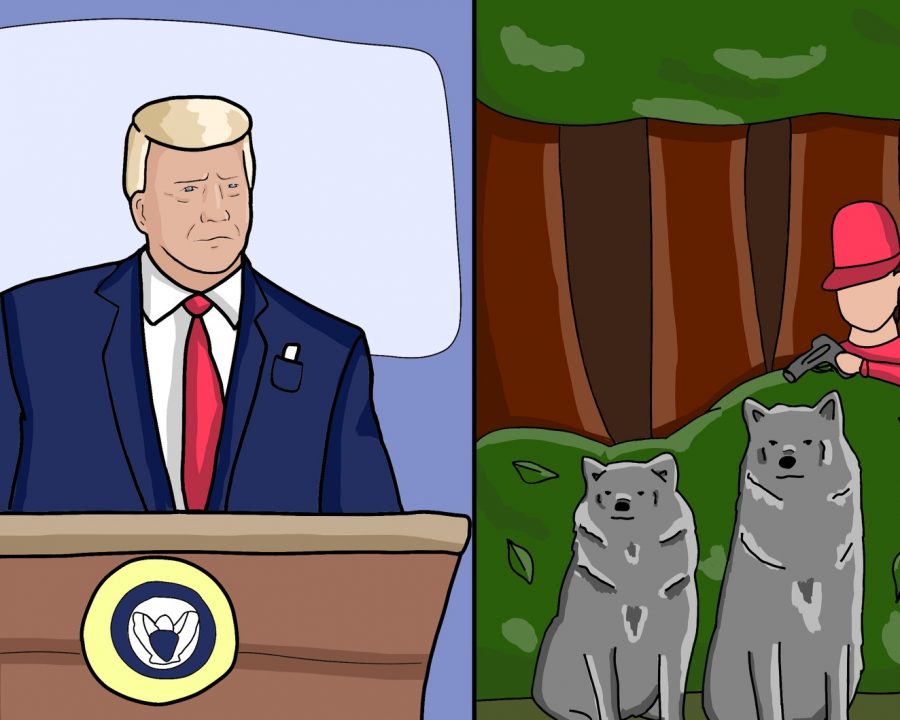Trump administration’s environmental “win” is actually a big problem
Assistant Opinion Editor Marin Klein writes that taking grey wolves off the endangered species list will bring them to the brink of extinction.
December 20, 2020
Deep in Montana and Wyoming, you can hear the chilling, yet beautiful howl of the grey wolves. These majestic creatures are once again roaming the United States after 50 years of conservation efforts.
The Trump administration announced they were stripping the grey wolves from the endangered species list on Oct. 29. The Trump administration claims that the species has made an impressive comeback since wildlife specialist of Yellowstone National Park brought wolves from Canada back into the States. They believe this warrants the action of taking wolves off the endangered species.
Taking wolves off the endangered species list seems like a good thing, right? Wrong.
While the population’s reintroduction exceeded expectations, taking them off the endangered species list means hunters have free reign to go for wolves once again.
Since the 1960s, wolves have been protected by the government after being heavily over hunted for game or for the protection of livestock. Many angry farmers with mauled cattle took it upon themselves to see that the wolves wouldn’t bother them anymore. When the Endangered Species Act was passed in 1973, there were only 500 grey wolves left in the entire country. Wolf packs disappeared in northern Michigan, Montana, Idaho, and many other northern states. This drastic decline of wolves led to their near extinction.
The wolf population has bounced back, but only in the Yellowstone area. Wolves used to populate most of the country, and those populations aren’t there anymore. For the past 45 years, many groups, along with the government, have worked hard to reintroduce wolves back into northern states past Yellowstone. These organizations, such as U.S Fish and Wildlife Services and The National Parks Service, have made great strides, but still have work to do.
With wolves off the endangered species list, they are new targets for hunters and farmers. Many people still have harsh feelings towards the wolf population, and will happily hunt all the wolves they can to protect their livestock. The chief executive of the Defenders of Wildlife, claims this as “premature and reckless” since the wolfs population is only at a fraction of what it once was. Allowing hunters to “protect their livestock” is going to hurt the population. This poses a problem for not only the wolves but their entire ecosystem.
When wolves became virtually extinct in the ‘60s, Yellowstone National Park’s environment was greatly affected. How much can one species affect a population? Well, a lot actually. Wolves are a keystone species, meaning they are a balance in an ecosystem. Without wolves, the ecosystem would fall apart. Wolves hunt grazing animals, like elk. If no wolves are around to hunt the elk, the land will become overgrazed, and plants will struggle to grow. With a lack of abundance of plants, the other grazing animals could starve. The wolves also lead to carcasses that provide food for other carnivores, like bears, or scavengers, like vultures. Wolves are the species that keeps an entire ecosystem running perfectly.
This is not a “commitment to species conservation” as the U.S. Fish & Wildlife Service’s press release states. This is a show of the administration’s neglect to look after our environment and the creatures living in it. Allowing these creatures, who have just begun to recover from extinction, to be put right back at the barrel of a gun is a blatant disregard of the grey wolf population and those who have dedicated their lives to rebuilding it.
The Trump administration’s failure to recognize this act as a step back, rather than a step forward is a blatant disregard for our environment and the wolves. Giving people the opportunity to hunt these animals again is going to put the population at risk, and they’ll be right back to where they started: on the brink of extinction.











